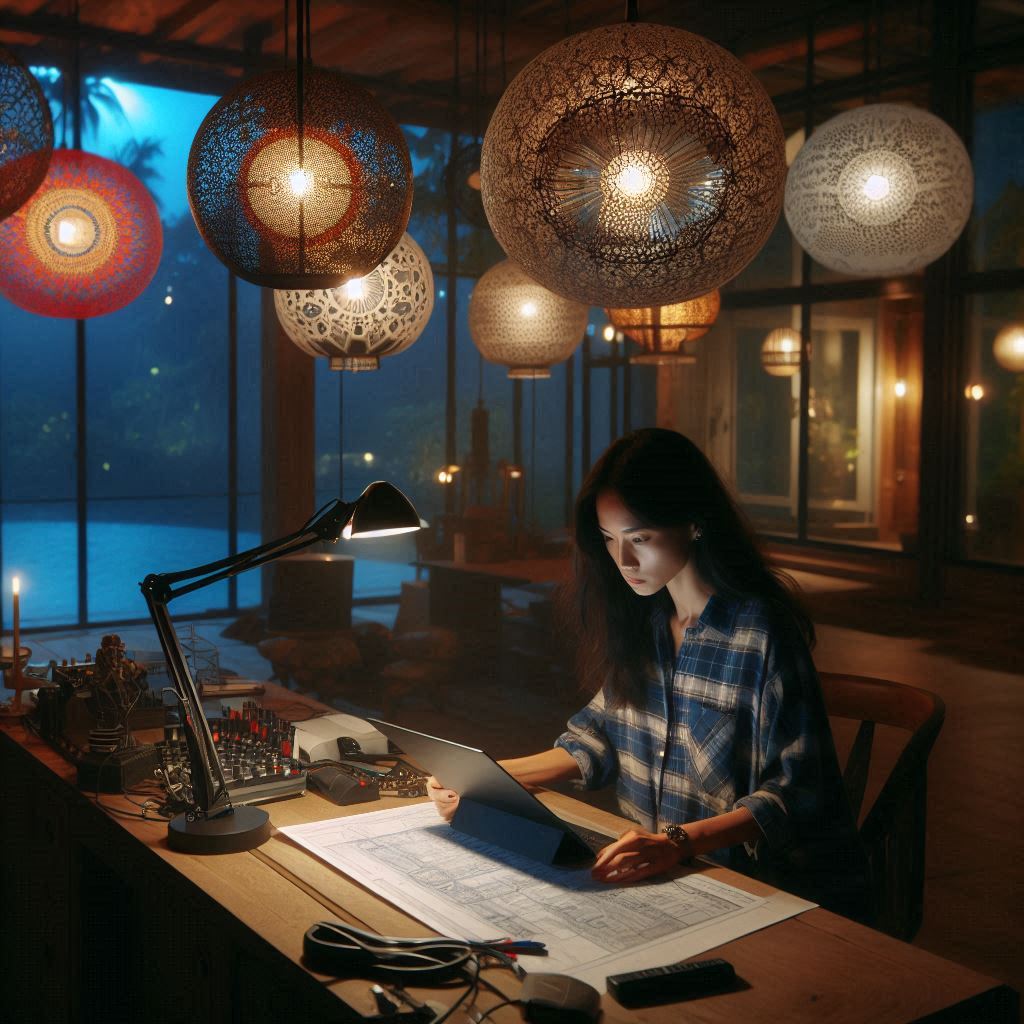Introduction
Lighting design plays a crucial role in shaping the atmosphere of any space.
As professionals in this field, lighting designers can choose between two primary career paths: freelance and in-house positions.
Each option offers unique benefits and challenges.
Freelance lighting designers operate independently.
They often work on a project-by-project basis.
These designers enjoy the freedom to select their clients and projects.
They set their own schedules and work environments.
This flexibility appeals to many creative professionals.
Freelancers can also diversify their portfolios by tackling various projects across different industries.
However, freelance work comes with uncertainties.
Freelancers often face inconsistent income streams.
They must actively market their services to secure new projects.
Additionally, freelancers bear the burden of business management.
This includes handling contracts, invoices, and taxes.
The lack of a stable paycheck can be daunting for some.
Freelancers also miss out on the benefits of full-time employment, such as health insurance and retirement plans.
In contrast, in-house lighting designers work for a specific company or organization.
They typically join design firms, theaters, or corporate entities.
These designers collaborate closely with teams and clients on various projects.
In-house positions often provide job stability and a predictable income.
Designers can focus entirely on their craft without the distractions of business management.
Yet, in-house roles have their drawbacks.
Designers may face limitations on creative freedom.
They often work within established brand guidelines and project parameters.
This can stifle innovation for those seeking to push boundaries.
In-house designers might also experience a more structured work environment.
This can lead to less flexibility in work hours and project selection.
Skills and Qualifications
Lighting designers play a critical role in enhancing visual experiences.
However, their paths diverge significantly based on their work environment.
Freelance lighting designers and in-house lighting designers possess unique skills and qualifications suited to their respective roles.
Necessary Skills and Qualifications for Freelance Lighting Designers
Freelance lighting designers must demonstrate versatility.
They handle various projects, from theater productions to corporate events.
A strong portfolio showcasing diverse work is essential.
Freelancers often need excellent self-promotion skills to attract clients.
Networking becomes crucial for securing gigs and building a reputation in the industry.
In addition to creativity, freelancers must be adaptable.
They may work on tight deadlines with limited resources.
Proficiency in lighting design software is vital for freelancers.
They should master programs like AutoCAD, SketchUp, or Vectorworks.
Strong project management skills help them juggle multiple projects simultaneously.
Time management is essential, especially when coordinating with clients and vendors.
Comparing Them to the Skills and Qualifications Required for In-House Lighting Designers
In-house lighting designers typically work for a single company, such as a theater or event production firm.
This position allows for specialization in specific types of projects.
In-house designers can focus on developing consistent branding and style for their employer.
As a result, they may dive deeper into the technical aspects of lighting design.
The qualifications for in-house lighting designers often include formal education.
A degree in lighting design, theater production, or a related field is common.
Many companies prefer candidates with experience in live events or stage productions.
In-house designers must also possess strong teamwork skills.
They collaborate closely with directors, set designers, and other team members.
Highlighting Any Differences or Similarities
Despite these differences, both freelance and in-house lighting designers share common skills.
Both roles require creativity and an eye for detail.
Understanding the principles of light and color is vital for both.
Excellent communication skills are essential to convey design ideas effectively.
Additionally, both types of designers benefit from strong problem-solving abilities.
They often face challenges that require quick and effective solutions.
In summary, freelance lighting designers thrive on versatility and adaptability.
Their success hinges on networking and self-promotion.
In-house lighting designers focus on specialization and collaboration within a structured environment.
While their paths differ, both roles require similar core skills.
Whether freelance or in-house, effective lighting design enhances visual storytelling and elevates experiences.
Read: Networking Events for Costume Designers
Job Flexibility
Flexibility That Comes with Being a Freelance Lighting Designer
Freelance lighting designers enjoy significant flexibility in their work schedules.
They can choose when and where to work.
This flexibility allows them to take on projects that match their interests.
Freelancers can also set their own hours, creating a more personalized work environment.
This autonomy leads to a better work-life balance, enabling them to prioritize personal commitments.
They can easily adjust their schedules for family events or other responsibilities.
This control over their time often results in increased job satisfaction.
Freelancers can also take breaks or vacations as needed, without worrying about employer approval or leave policies.
Contrast It with the Structure and Schedule of an In-House Position
In contrast, in-house lighting designers typically face a more structured schedule.
They usually work fixed hours, often from 9 AM to 5 PM.
This structure can limit their freedom to choose when to work.
While in-house positions offer stability, they often come with a set routine.
Employees must adhere to their employer‘s policies and schedules, which can feel restrictive.
In-house designers might also face mandatory meetings and project deadlines.
These requirements can hinder their ability to work during their most productive hours.
The Impact on Work-Life Balance
The flexibility of freelance work has its perks, particularly regarding work-life balance.
Freelancers can craft a schedule that aligns with their personal lives, often feeling a sense of control over their time.
This autonomy can lead to greater happiness and reduced stress.
In-house designers, while secure, might struggle with maintaining a healthy work-life balance.
Their fixed schedules can interfere with personal commitments, leading to frustration.
They may feel pressured to work overtime or attend events outside normal hours, which can lead to burnout.
However, in-house designers benefit from predictable income.
They receive a consistent salary and often enjoy benefits such as health insurance.
This security can provide peace of mind, especially during economic uncertainty.
Yet, the lack of flexibility can lead to dissatisfaction over time.
In summary, freelancers enjoy flexibility and control over their schedules, enhancing their work-life balance.
In-house designers offer stability but often sacrifice flexibility.
Ultimately, the choice depends on personal preferences and career goals.
Read: Building a Portfolio for Costume Design
Project Variety
Freelance lighting designers typically work on a wide range of projects, from small residential designs to large commercial installations.
Types of projects freelance lighting designers typically work on
Residential Projects
Freelancers often work on residential projects such as lighting designs for homes, apartments, and outdoor spaces.
These projects allow designers to focus on creating personalized lighting solutions for individual clients.
Commercial Projects
Freelancers also take on commercial projects like restaurants, retail stores, and offices.
These projects require a different approach, as designers need to consider not only aesthetics but also functionality and brand identity.
Event Lighting
Event lighting is another common type of project for freelance designers.
They create lighting designs for weddings, parties, concerts, and other special events, adding ambiance and enhancing the overall experience.
On the other hand, in-house lighting designers may primarily focus on a specific type of project, such as designing lighting systems for a particular company or industry.
Corporate Projects
In-house designers often work on corporate projects, designing lighting solutions for office buildings, conference rooms, and other corporate spaces.
These projects require designers to adhere to the company’s brand guidelines and corporate image
Industrial Projects
In-house designers may also work on industrial projects, such as warehouses, factories, and manufacturing facilities.
These projects focus on functionality and safety, requiring designers to prioritize energy efficiency and compliance with regulations.
Some in-house designers specialize in public projects, like museums, theaters, and public spaces.
These projects have a strong emphasis on creativity and storytelling, with designers creating immersive lighting experiences for visitors.
Benefits
Flexibility to choose projects based on personal interest and schedule.
Opportunity to work with a diverse range of clients and industries
Transform Your Career Today
Unlock a personalized career strategy that drives real results. Get tailored advice and a roadmap designed just for you.
Start NowStability of consistent projects and steady income.
Opportunity for career growth and advancement within the company.
Drawbacks
Inconsistent income due to project-based work.
Difficulty in establishing long-term relationships with clients.
Potential lack of creative freedom and variety in projects.
Limited exposure to different industries and client types.
Ultimately, the choice between freelance and in-house work comes down to personal preferences and career goals.
Both options offer unique opportunities for lighting designers to showcase their creativity and skills in different project settings.
Read: Visual Merchandiser: Job Market and Opportunities
Job Security
The job security of freelance lighting designers
When it comes to job security, freelance lighting designers typically face a more uncertain future compared to their in-house counterparts.
Freelancers are dependent on securing projects and clients to ensure a steady income.
This dependency on finding work can lead to periods of financial instability and unpredictability.
On the other hand, in-house lighting designers working for a company or organization usually have more stability in terms of employment.
They have a consistent source of income and may also have access to benefits such as healthcare and retirement plans.
This steady paycheck can provide a sense of security and peace of mind.
Freelance lighting designers are exposed to the risks of fluctuating project demand and competition in the market.
They must continuously market themselves, network, and maintain a strong reputation to attract clients and secure projects.
This constant hustle and need for self-promotion can be exhausting and stressful.
the stability of being an in-house designer
In-house designers are often shielded from the uncertainties of the freelance world.
They typically have a dedicated workload from their employer and do not have to worry about finding new projects or clients.
This structure can offer a sense of job security and relief from the pressures of freelancing.
Although freelancers may face higher risks in terms of job security, they also have the potential for greater rewards.
The risks and rewards associated with each option
Freelancing allows for more flexibility and control over one’s schedule and projects.
This autonomy can lead to increased creativity, satisfaction, and personal growth.
On the other hand, in-house designers may have less autonomy and flexibility in their work.
They must adhere to the company’s guidelines, deadlines, and expectations.
While this structure can provide stability, it may limit creativity and professional development.
In fact, the job security of freelance lighting designers is characterized by uncertainty and fluctuation, while in-house designers enjoy more stability and consistency.
Each option comes with its own set of risks and rewards, and ultimately, the decision between freelance and in-house work depends on individual preferences and priorities.
Read: Visual Merchandising: Best Practices for Beginners

Delve into the Subject: Emerging Trends in Industrial Design for 2024
Explore Further: Exploring the History of Lighting Design
Network Building
Building a strong network is crucial for freelance lighting designers as it can open up a plethora of opportunities.
For freelance designers, networking is a way to connect with potential clients, collaborators, and industry professionals.
Attending industry events, conferences, and trade shows provide ample opportunities for freelance designers to expand their network.
Benefits of Networking for Freelance Designers
- Increased visibility and credibility in the industry.
- Access to potential projects and clients.
- Collaboration opportunities with other creative professionals.
- Knowledge sharing and learning from industry peers.
On the flip side, in-house lighting designers may have limited networking opportunities compared to their freelance counterparts.
Showcase Your Business Today
Reach thousands of readers actively exploring professional services. Publish your business profile and grow your audience now.
Publish NowWorking within a single company may restrict the exposure and connections that in-house designers can make within the industry.
However, in-house designers can still build a network by attending relevant industry events, workshops, and seminars.
Impact of Networking on Career Growth
- Networking can lead to new job opportunities and collaborations.
- It can help in-house designers stay updated with industry trends and best practices.
- Building a network can also result in mentorship opportunities and professional development.
- Networking can enhance the reputation and credibility of both freelance and in-house designers.
In general, networking is a powerful tool that can significantly impact the career growth of both freelance and in-house lighting designers.
By actively building and nurturing their networks, designers can create new opportunities, foster collaborations, and stay ahead in their respective fields.
Delve into the Subject: Top Interior Design Trends Influencing Furniture
Financial Considerations
Explore the Financial Aspects of Freelance Lighting Design
Freelance lighting designers often have higher earning potential than in-house counterparts.
They can set their rates based on experience, project complexity, and client budgets.
This flexibility allows freelancers to charge hourly rates ranging from $50 to $150 or more.
However, this comes with uncertainty.
Freelancers may experience fluctuating income due to the nature of project-based work.
They must consistently market their services to find new clients, which requires time and effort.
Earning Potential to That of In-House Designers
In-house lighting designers typically receive a steady salary.
This salary provides financial stability but may limit earnings.
The average salary for in-house designers varies by location and experience, usually ranging from $50,000 to $80,000 annually.
In contrast, freelancers can earn significantly more on a single project, depending on their workload.
They have the potential to earn more during busy periods, but this comes with the risk of droughts in income during slower times.
Costs and Expenses Associated with Each Role
Freelancers must account for various costs and expenses.
They need to invest in their tools and equipment, such as lighting design software and high-quality computers.
These costs can be substantial and vary depending on project needs.
Additionally, freelancers pay for their health insurance and retirement plans, which can add up quickly and eat into profits.
Taxes are another consideration, as freelancers must manage their tax obligations based on fluctuating income levels.
In-house designers enjoy several financial perks that freelancers may not.
Companies typically cover health insurance and retirement benefits for in-house employees.
This additional financial support significantly enhances overall compensation.
In-house designers also receive paid time off and holiday pay, contributing to job security.
These benefits provide peace of mind that freelancers might not always have.
Ultimately, the choice between freelance and in-house lighting design hinges on individual financial goals and preferences.
Freelancers can enjoy higher potential earnings but face more risks.
In-house designers may experience stable salaries and benefits, but with limited income growth.
Understanding these financial considerations is essential for making an informed decision about your lighting design career.
Evaluate your financial situation, lifestyle, and long-term goals carefully.
Both paths offer unique advantages and challenges in the dynamic field of lighting design.
Company Culture
The Role of Company Culture for In-House Lighting Designers
Company culture plays a significant role for in-house lighting designers.
It shapes their daily experiences and influences their work environment.
In-house designers often thrive within a defined culture that emphasizes collaboration and teamwork.
They enjoy the benefits of shared goals and a collective vision.
Strong company culture fosters camaraderie and support among colleagues.
This creates a sense of belonging that many in-house designers appreciate.
Contrast It with the Independence of Freelance Designers
In contrast, freelance designers operate independently.
They have the freedom to choose their projects and clients.
This independence allows freelancers to craft their work style and schedule.
However, they miss out on the structured environment that company culture provides.
Freelancers often work alone, which can lead to feelings of isolation.
While they enjoy flexibility, they may not experience the same level of community as in-house designers.
The Impact of Company Culture on Job Satisfaction
The impact of company culture on job satisfaction is substantial.
In-house designers often feel a sense of stability and security.
They are part of a larger organization that provides resources and support.
This stability can lead to higher job satisfaction.
Designers who feel valued within their company are likely to be more engaged.
They often take pride in contributing to a shared vision and mission.
Conversely, freelancers may experience fluctuating job satisfaction.
Their independence can lead to uncertainty about future projects.
They must continually seek new clients to maintain income.
This can create stress and anxiety, impacting their overall satisfaction.
However, many freelancers find satisfaction in their autonomy.
They enjoy the ability to select projects that align with their values and interests.
Company culture also influences career development opportunities.
In-house designers often have access to training and mentorship.
This can enhance their skills and promote professional growth.
Organizations with strong cultures invest in employee development.
This investment helps in-house designers advance their careers.
Freelancers must take the initiative to seek out learning opportunities.
They may miss out on mentorship and structured growth pathways.
Ultimately, company culture shapes the experiences of in-house designers.
It fosters collaboration, support, and growth.
Freelance designers enjoy independence but face unique challenges.
Their experiences differ significantly, impacting job satisfaction.
In-house designers often benefit from a sense of belonging.
Freelancers find fulfillment in their freedom and choice.
Both paths offer unique advantages and challenges in the lighting design field.
Conclusion
After examining the pros and cons of freelance and in-house lighting design roles, it is clear that each option offers unique advantages and challenges.
Freelancers enjoy flexibility and varied projects, while in-house designers benefit from stability and team collaboration.
It is important for aspiring lighting designers to carefully consider their career goals and preferences before choosing between freelance and in-house roles.
By assessing their long-term objectives and work style, individuals can make an informed decision that aligns with their professional aspirations.
For those seeking further research on this topic, resources such as industry journals, professional associations, and online forums can provide valuable insights into the differences between freelance and in-house lighting design roles.
Exploring these resources can help individuals gain a deeper understanding of the opportunities available in both careers and decide which path is the best fit for their unique circumstances.
[E-Books for Sale]
The Big Book of 500 High-Paying Jobs in America: Unlock Your Earning Potential
$19.99 • 500 High-Paying Jobs • 330 pages
Explore 500 high-paying jobs in America and learn how to boost your career, earn more, and achieve success!
See All 500 High-Paying Jobs of this E-Book
1001 Professions Without a Degree: High-Paying American Jobs You Can Start Now
$19.99 • 1001 Professions Without a Degree • 174 pages
Discover 1001 high-paying jobs without a degree! Unlock career tips, skills, and success strategies for just $19.99!




